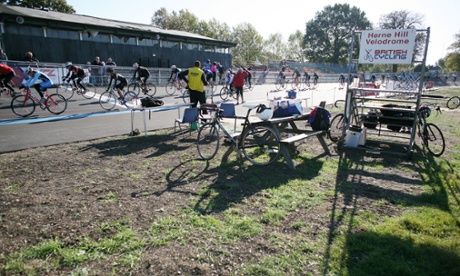
Tucked away down an unremarkable south London suburban street lies a unique piece of cycling heritage that, just three years ago, was in danger of closing forever. But the latest chapter in the rebirth of Herne Hill’s historic velodrome involves a set of blueprints for a state-of-the-art pavilion.
Hopkins Architects – the team behind the outstanding Olympic velodrome in Stratford, east London – last month revealed its plans to the public. Now only the formality of planning permission stands in the way of the pavilion rebuild – “priced conservatively at £1.9m” according to the velodrome website.
The planned two-storey, ultramodern facility will include a gym, changing rooms and showers, plus office, physio rooms and coaching facilities. Members will be able to rest their legs in a new upstairs club room, with kitchen. Here the focus will be a public cafe with verandah, providing a small stadium feel.
There are also plans for a children’s track and a family circuit. Proposals for a more ambitious pavilion – twice as large as the current scheme – were abandoned in 2013 due to difficulties with funding and access.
The improvements are a long time coming for this atmospheric cycling venue, which by many standards should really be a listed building. Built in 1891, it is the only extant venue of the 1908 and 1948 Olympic Games. In its heyday in the 1920s and 30s it regularly drew crowds of more than 10,000, and was briefly the home of Crystal Palace football club during the First World War. Famously, Sir Bradley Wiggins’ triumphant journey to the Champs-Elysees began at Herne Hill, where he trained from the age of 12. Joanna Rowsell and Laura Trott also raced here.
In the postwar years, the venue’s popularity diminished, along with cycling as a sport in general. By 2003, owners Southwark Sports had allowed the site to fall into disrepair – it was so neglected that it even closed its doors that year. But somehow the track staggered on – new site tenants Veloclub De Londres with British Cycling managed to coax a series of short leases from landowners The Dulwich Estate drumming up a big membership base. But with money scarce, the old wooden pavilion – also built in 1891 – became derelict and was declared unsafe a decade ago. Finally, just three years ago, it looked as if the UK’s oldest cycle track could close altogether as its lease drew close to expiry.
Something had to be done to save the venue. “The future of this incredible site was uncertain,” said Hillary Peachey, chair of the Herne Hill Velodrome Trust, at the time. “The lack of a long-term lease and a series of harsh winters was threatening to overcome all the hard work that had been put in to the track over the decades, and there was a very real threat of closure.”
The Save the Velodrome campaign and the Herne Hill Velodrome Trust, the charity it established, with high-profile support from local MP Tessa Jowell and Olympic boss Lord Coe, raised over £40,000, giving British Cycling something to put on the table during lease negotiations with the landowners, The Dulwich Estate.
The wheels were rolling. With a new lease, British Cycling was now able to finance the resurfacing of the track to the tune of £400,000. Then, in 2013, Southwark’s Olympic Legacy programme funded a new junior track and multi-use game area on the inside of the track, plus new track lighting to allow use of the track during winter.
Finally, Sport England and the London Marathon Trust – buoyed by the Olympic Games successes – committed to finance pavilion construction costs up to £1.5m.
The facilities have been designed with a host of users and abilities in mind, says Peachey. “This is a wonderful and historical site, and [is being redeveloped] with the support of stakeholders, local politicians, councillors, residents and the cycling community.”
The pavilion will be for public and private use. “It’s a thriving cycling facility for use by schools, universities, cycling clubs from across London, the disabled, elderly and local community groups,” says Peachey. The trust says some of the pavilion space will be available to suitable commercial interests – the cafe for instance – while part of the venue could be open for occasional function hire. All this will help fund the site in perpetuity and help to improve other parts of the site – including general landscaping and improving the mountain bike course.
Andrew Edge, an architect working on the velodrome design at Hopkins, says the firm has prepared a planning application to Southwark council and that “by late August, start of September, we should hear if we have been successful”. Hopkins – working free of charge – says works should take six months with the pavilion open by summer 2015.
If all goes to plan, construction should start by the end of 2014 and Herne Hill velodrome’s motto “a good wheel to follow” should be true for generations to come.

